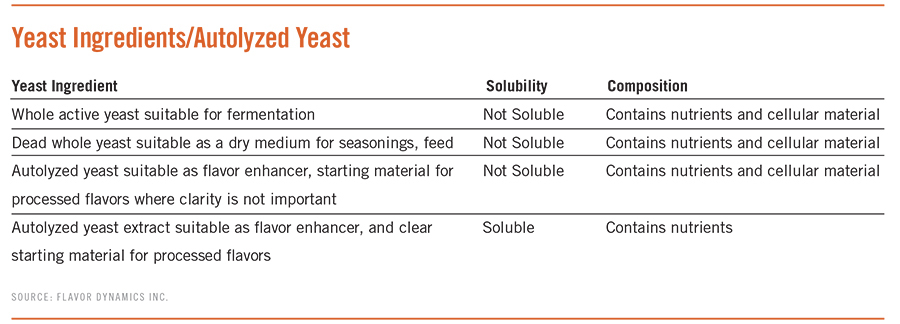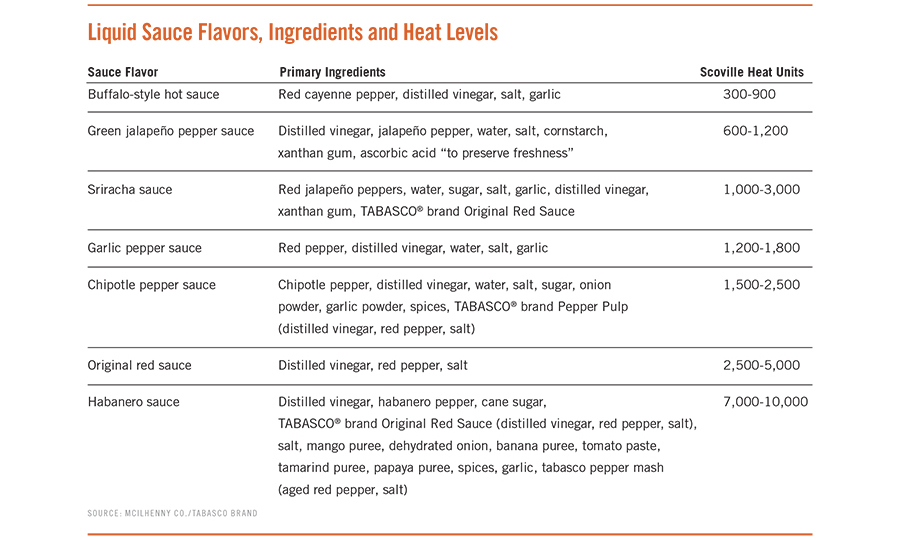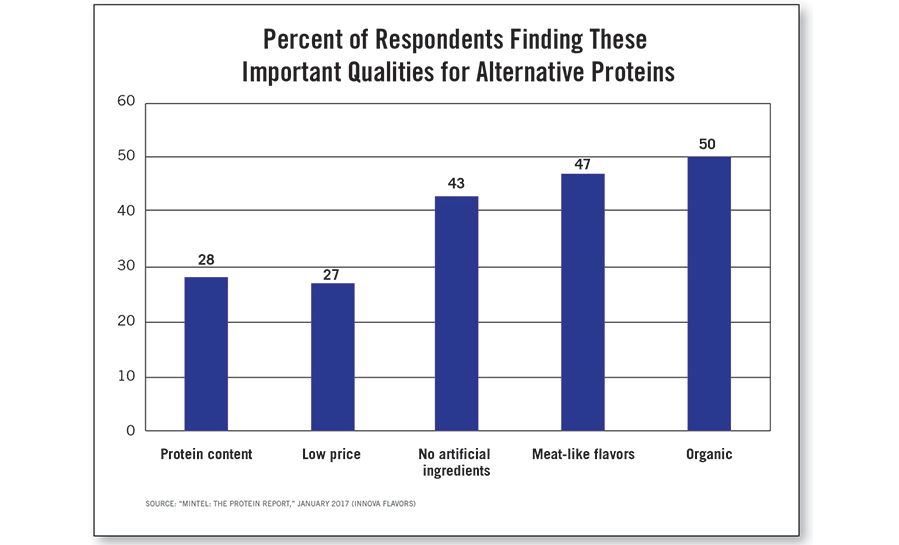Natural Flavors—A Code of Federal Regulations Perspective
Although the FDA is looking to define “natural” as it pertains to food products in general, the Code of Federal Regulations (CFR) does define “natural flavor” in current regulations. According to the CFR, the term “natural flavor” or “natural flavoring” means the essential oil, oleoresin, essence or extractive, protein hydrolysate, distillate; or any product of roasting, heating or enzymolysis that contains the flavoring constituents derived from a spice, fruit or fruit juice, vegetable or vegetable juice, edible yeast, herb, bark, bud, root, leaf or similar plant material, meat, seafood, poultry, eggs, dairy products, or fermentation products thereof, whose significant function in food is flavoring rather than nutritional.
“As early as 4500 BC,” explained Dolf DeRovira, president, Flavor Dynamics Inc., “essential oils have been used for medicinal purposes, as fragrances and as religious offerings. Essential oils, by definition, contain volatiles vs. fixed oils, which contain non-volatiles.” DeRovira’s R&D Seminar was titled “Natural Flavors—A Code of Federal Regulations Perspective.”
Oleoresins are semi-solid extracts containing the oil-soluble essence of a natural product. Mostly comprised of non-volatiles, oleoresins can have volatile constituents as well. Naturally occurring oleoresins are gums and balsams. Myrrh and frankincense are the most commonly referenced balsams in the Bible.
Today, black pepper oleoresin, defined in the CFR as natural flavor, is made from the extraction of black pepper seeds through petrosolvent extraction and the subsequent removal of that solvent. The result is an oily substance with 50% to 55% peperine, the active heat principle. Some peperidine, the characteristic volatile of the black pepper, is also found in the essential oil.

Yeast and yeast extracts have differing properties, depending on the form of the ingredient, and are useful in a variety of applications.
Protein hydrolysates, another type of natural flavor, are yeast extracts and hydrolyzed plant proteins. Autolyzed yeast extract contains yeast nutrients but no cellular materials. It is suitable as a flavor enhancer and a clear starting material for processed flavors. Hydrolyzed plant proteins are made from wheat gluten, the isolated protein from wheat, or from soy or corn proteins.
Products of roasting and toasting also create natural flavors. During the Maillard reaction, a non-enzymatic browning reaction occurs between amino acids and reducing sugars, while being heated. As a result, pyrazines, thiazoles, thiazolines, pyrimidines, oxazolines, oxazoles, furans, furanones, aldehydes and many other compounds are created. These compounds are all considered “brown” notes found in certain cooked foods. The other type of browning, enzymatic browning, is how bananas turn brown, due to the enzyme polyphenyloxidase. Some products, such as chocolate, utilize both enzymatic and non-enzymatic browning.
Enzyme-modified cheese is a natural flavor made by inoculating fresh green cheese with enzymes, resulting in a flavorful addition to foods and snacks. DeRovira went on to explain: “Natural chemicals fermented in the flavor industry are easily defined as natural. Classes of compounds derived in this manner include lactones, aldehydes, acids, esters, ketones and alcohols.”
Throughout history, foods have been obtained by use of fermentation and microbial action, through their enzymes and metabolic pathways. A few examples are yogurt, sauerkraut, kimchi, fish sauce and beer.
“Natural Flavors–A Code of Federal Regulations Perspective,” Dolf DeRovira, president, Flavor Dynamics, Inc., dolfd@flavordynamics.com, 908-822-8855
—Summary by Elizabeth Pelofske, Contributing Editor
Bridging the Flavor Gap to Create Value and Enhance Consumer Satisfaction
Packaged foods, which are often industrially cooked rapidly in high-humidity processes, often benefit by the addition of flavoring systems to impart the familiar, distinctive tastes created during home cooking. Flavor compounds from the preparation method are created when frying, grilling, roasting, sautéing, baking, smoking, toasting, searing, broiling, blackening and so forth.
“Savory reaction flavors can help overcome industrial thermal processing challenges by delivering the missing or diminished top-notes otherwise imparted by traditional ‘back of the house’ cooking techniques,” explained Dr. Bob Johnson, business development director for Red Arrow Products, in his R&D Seminar presentation titled “Bridging the Flavor Gap to Create Value and Enhance Consumer Satisfaction.”
For example, ground beef with added Natural Prime Rib Beef Flavor will take on a savory, caramelized-beefy, juicy (medium-rare) flavor. Red bell peppers with a char flavor added will show intensified character and taste more like char-roasted red bell peppers. Chicken breast cooked with natural roast chicken flavor WONF will have imparted the authentic brown notes, such as pan roasted drippings and crisped skin.
Savory reaction flavors result from a combination of natural compounds reacted at specific temperatures, time and pH to create desired flavors. These are composed of carbohydrates, proteins, fats and oils, and vitamins. Essentially, what is happening is the formation of pyrazines, thiazoles, thiophenes, furans, furanones, pyrroles, aldehydes and ketones.
“Reactions used to create flavors include the Maillard reaction, oxidation, degradation, polymerization and hydrolysis. Key flavor compounds created during actual grilling, roasting and frying, for example, are identified through instrumentation, and then made into flavoring ingredients,” Johnson added.
Using sensory analysis, assessing flavor comparisons to those from traditionally prepared “gold standards” are conducted to ensure authenticity, balance and intensity are appropriate.
Attributes in these flavors can be adjusted by simply changing an amino acid used in the reaction. For example, dextrose reacted with cysteine gives sulfur and chicken attributes, while changing to lysine gives toasted bread, roasted tomato and red wine flavors. Dextrose with methionine results in fried potato or cabbage flavors, while dextrose with phenylalanine gives honey, chocolate or caramel flavors.
Popularity for grilled and/or smoked food continues to rise, which has increased the need for differentiation.
“Customizing flavors meets specific needs. Within the grill flavor category, there are many variations of grill: wood-fired, charcoal, gas-fired, fire-roasted, flame-seared, charred or seared. Further, smokes can be customized via type of wood species used, wood-smoldering temperature, aging or via blending. Smokes can range from fairly robust, pit-smoked style to a sweet, mellow fruit wood—and virtually anywhere in between,” said Johnson.
Innovation in this category has led to development of naturally smoked ingredients that include, sugar, garlic, onion and maltodextrin that can be used as an ingredient in the food or on top, applied in a rub or seasoning.
For smoke flavors, these processes include only wood, heat and water. The particulate phase, which includes the tar and fly ash, is removed through filtration and aging. The EU has said that use of condensed natural smokes produced from smoke that has been subjected to fractionation and purification, is considered less of a health risk than traditional smoking processes. Tars that contain cancer-causing polycyclic aromatic hydrocarbons are removed from condensed natural smokes.
Reaction flavor ingredients offer food manufacturers bold, authentic flavors; consistency in quality; plus, cost-effectiveness, versatility, ease-of-use and clean labels.
“Bridging the Flavor Gap to Create Value and Enhance Consumer Satisfaction,” Dr. Bob Johnson, business development director, Red Arrow Foods, 920-629-0407, r.johnson@redarrowusa.com
—Summary by Elizabeth Pelofske, Contributing Editor
Iconic Flavor for Every Formula
The story of McIlhenny Company, TABASCO® brand began with Edmund McIlhenny wanting to improve the taste of bland food following the U.S. Civil War. Newly harvested peppers were mashed with a small amount of Avery Island salt and left to ferment and age. Finally, the aged red pepper mash was mixed with premium distilled vinegar and strained to remove seeds and skins. The resulting mixture was placed in small cologne-shaped bottles and duly labeled, TABASCO brand Pepper Sauce.
Production today still takes place on Avery Island, located in New Iberia, La., about 140 miles east of New Orleans. The home of TABASCO brand is surrounded by swamps and marshes and sits on one of five salt domes on the Louisiana Gulf Coast. Today, approximately 70,000 bottles are produced on Avery Island each day, which are distributed to 195 countries and territories and packaged in 22 different languages and dialects.
“Since 1868, the McIlhenny family has been committed to premium products that enliven the flavor of food. Our mission is to assure that the TABASCO diamond provides uncompromising quality,” said Judson McLester, corporate chef and industrial ingredients sales manager, for McIlhenny Co., TABASCO Brand.
McLester explained, “Today, the company’s portfolio includes the iconic family of flavors and Industrial Ingredients division, all made through a unique process that includes aging for flavor because you cannot hurry perfection.”

The TABASCO Family of Flavors offers a range of pepper sauces with varying heat levels to enhance many food applications.
Liquid sauces now include Original Red Sauce, plus seven additional flavors ranging in heat levels. Bulk flavorings with intermediate moisture include Pepper Paste (milder oak barrel-aged tabasco pepper mash, with vinegar and pungent fermented sweet notes); Processor’s Blend (strong oak barrel-aged tabasco pepper mash, vinegar and pungent fermented sweet notes); and Ground Wet Seed (fermented pepper taste with slight vinegar notes). Dry formulations provide a range of pepper flavors and heat levels for many applications and include the TABASCO brand Spray Dry Flavoring, a new Chipotle Spray Dry Flavoring, Dry Red and Crushed Red Pepper.
The heat level or spiciness of peppers is rated on a Scoville Heat Scale, which measures capsaicin—the chemical in peppers responsible for their heat. Capsaicin is found in the tissue of chili peppers, adding a kick to foods. More capsaicin means more heat and more flavor.
The liquid pepper sauces have various heat levels, ranging from lower relative values of 600-1,200 SHUs in Green Jalapeño Pepper Sauce, up to 10,000 SHUs in the Habanero Sauce.
With TABASCO brand Products, it is not all about the heat. The products are aged for flavor, with the recognized quality of a family-owned company, now providing a variety of flavors and formats. Industrial Ingredients from TABASCO brand offer the unique flavor profile of Original Red Sauce in a variety of convenient forms to fit most food-processing environments.
Said McLester, “Our portfolio is the solution to develop new flavor profiles or enhance existing flavors of sweet and savory food and beverage products.”
“Iconic Flavor for Every Application,” Judson McLester, corporate chef and industrial ingredients sales manager, McIlhenny Co., TABASCO Brand, ingredients@TABASCO.com, 337-373-6105
—Summary by Elizabeth Pelofske, Contributing Editor
Plant Based Diets and Impact on Flavor Application
Health and nutrition are big diet drivers today and, according to surveys, 39% of women and 32% of men claim to eat at least one vegetarian meal per week. Plant-based diets are growing in popularity, but that is relatively new. Meat is thought to be crucial in human brain evolution over time. In the early 1900s, dietary recommendations were developed to prevent disease from deficiency of essential nutrients. From 1913-1979, diet guides focused mainly on meat and dairy products but during 1958-1979, the basic four food groups were relied upon: meat, dairy, fruits and vegetables, and grains.
In the late 1970s, dietary guides changed to recommend reducing intake of energy, fat, saturated fat, cholesterol, sugar, salt and alcohol; and to increase intake of complex carbohydrates and fiber. Advice was then phrased in terms of nutrients and not of foods.
1980 saw the first official release of the Dietary Guidelines for Americans, updated every five years since then. The 2010 and 2015 Dietary Guidelines recommended eating healthy across the lifespan, focusing on variety, nutrient density and amount. Limiting calories from added sugars and saturated fats, and reducing sodium are still recommended by shifting to healthier foods and beverages.
“Regardless of dietary recommendations, a high percentage of the U.S. population does not consume enough vegetables, fruit, grains or dairy, but take in too much added sugars, saturated fats and sodium,” stated Dafne Diez de Medina, vice president-innovation R&D, for Innova Flavors. “Over the years, meat consumption has declined, due to concern over food safety, heart health and animal welfare.”

Consumers want alternative proteins with high/good protein content, no artificial ingredients, meat-like flavors, organic claims and competitive prices. The main deterrents to consumption of alternative proteins are taste and texture.
Demand has been growing for plant proteins in beverages, bars and other foods. From 2012-2016, plant-based product claims have grown by 35.8%, being driven by both demand for protein, and for “clean eating.” In the US for example, pea protein is seen as nutritious and sustainable.
Sustainability is an important factor when purchasing a protein product, and people want natural ingredients. A survey of 710 respondents in 2017 asking about alternative protein consumption showed 471 alternative protein users and 239 non-users. Of the users, vegetable proteins, legumes, nuts and seeds, and eggs were the most common protein consumed. Soy protein or tofu, and some other proteins, had fewer users because of the taste and texture, but use of flavoring ingredients can help improve products containing plant proteins.
High-quality textured vegetable protein burgers, veggie Italian sausage, veggie lamb sausage, veggie burgers, black bean burgers, lentil vegan meatballs, chicken free strips and tofu veggie burgers have all been formulated successfully, using the right formulas and flavorings.
Two mega-trends in the food space are protein demand and clean eating. Plant protein alternatives continue to be of interest for consumers. The food industry is still adjusting to these trends, but help is available.
“Evolution of Plant Based Diet and Impact on Flavor Application,” Dafne Diez de Medina, VP-innovation R&D, Innova Flavors, ddiezdemedina@innovaflavors.com, 708-837-3545
—Summary by Elizabeth Pelofske, Contributing Editor

